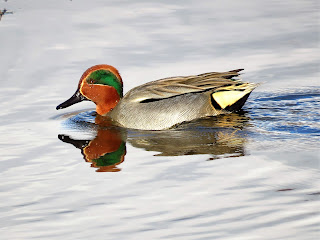A trio of Chaffinches seem unconcerned about the Mallard. We see the curly tail on the drake Mallard – a very strong gene that is present in most drake hybrids.
What exactly is the evolutionary path that produces the extraordinary plumage on this male Pheasant?
The feeders were alive with tits of course. Here is, obviously, a Blue Tit. Apparently the eyes of Blue Tits ‘see’ their blue the same way as we see the blue of Kingfisher. Looks quite vivid to me anyway.
And an always engaging Long-tailed Tit.
A female Chaffinch is actually quite attractive if understated.
Rather shy today and the lone example we found was this female Brambling. Although a male would not have the full black head of a breeding adult yet it would show a vertical black area between the bill and the eye. There would also be some yellow on the bill.
The strong rufous colouring, especially on the neck, and the relatively large ears means this is a Bank Vole.
The rufous tone is well illustrated here.
He was also part of the synchronised drowning competition – he is on the left with the brighter undertail.
A fine drake (Common) Teal in great light. Note particular the long scapulars hanging across the back.
And a pair of (Common) Teal. Note the short pale horizontal stripe under the duck’s tail. This can be used to identify ducks of this species from all other small brown ducks even at long range.
A rather better shot of a pair of Shoveler with the drake keeping a careful eye on me.
There were a number of very busy Common Snipe running around and feeding – hence hard to ‘freeze’ the action. Note the rufous tail-feathers. It is now thought that birds with ‘brighter’ tail feathers are in better condition. The result is that these feather, held open to vibrate in the air when the bird does its diving display flight, make more noise as they are also stronger. This indicates a ‘better’ mate to the females on the ground.
(Ed Wilson)

















